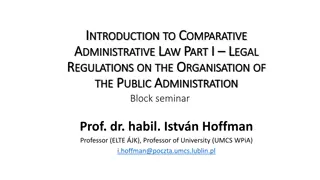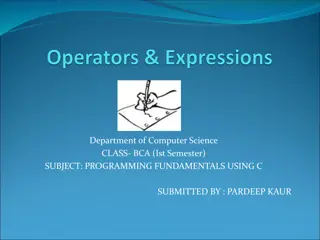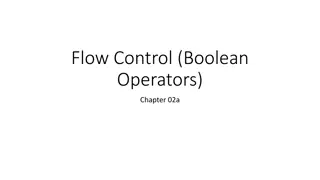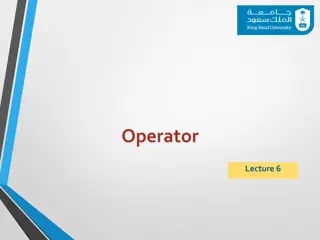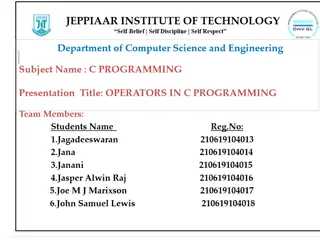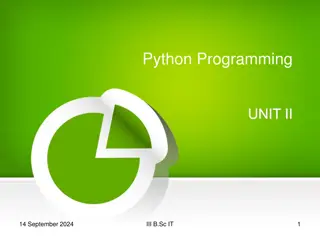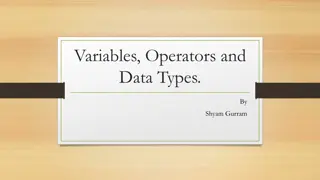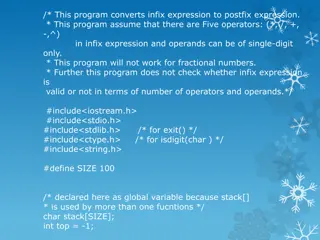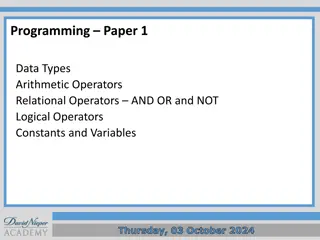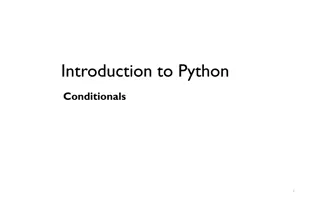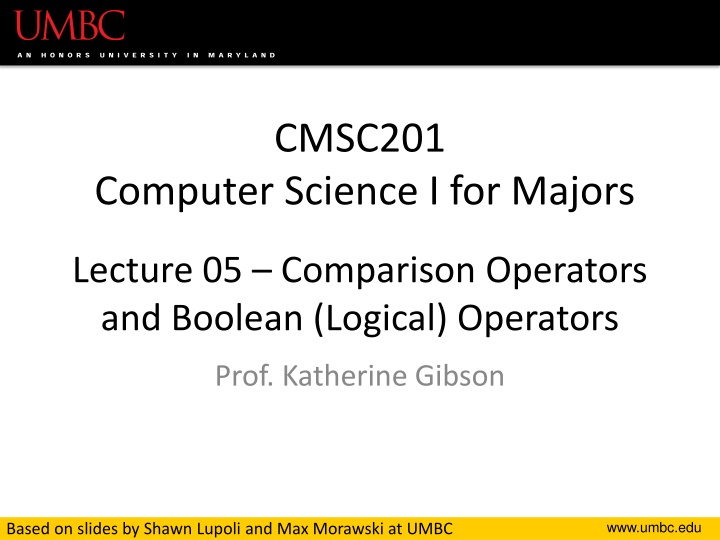
Python Comparison and Logical Operators in CMSC201 Lecture
Explore the concepts of Python comparison and logical operators in CMSC201 Lecture 05. Learn about expressions, data types, constants, and functions in Python programming. Discover how to use main() in organizing your code effectively.
Download Presentation

Please find below an Image/Link to download the presentation.
The content on the website is provided AS IS for your information and personal use only. It may not be sold, licensed, or shared on other websites without obtaining consent from the author. If you encounter any issues during the download, it is possible that the publisher has removed the file from their server.
You are allowed to download the files provided on this website for personal or commercial use, subject to the condition that they are used lawfully. All files are the property of their respective owners.
The content on the website is provided AS IS for your information and personal use only. It may not be sold, licensed, or shared on other websites without obtaining consent from the author.
E N D
Presentation Transcript
CMSC201 Computer Science I for Majors Lecture 05 Comparison Operators and Boolean (Logical) Operators Prof. Katherine Gibson www.umbc.edu Based on slides by Shawn Lupoli and Max Morawski at UMBC
Last Class We Covered Expressions Python s operators Including mod and integer division The order of operations Different variables types How to cast to a type Constants (and why using them is important) 2 www.umbc.edu
Any Questions from Last Time? www.umbc.edu
Todays Objectives To learn a bit about main() To learn more of Python s operators Comparison operators Logical operators To practice using these new operators To become more familiar with using Boolean variables 4 www.umbc.edu
Quick Note about main() www.umbc.edu
main() In Lab 2, we introduced the code def main(): as the first line of code in our file main() is an example of a function We can use functions to organize our code 6 www.umbc.edu
Functions We ll cover functions in more detail later For now, think of them as something similar to a variable Variables hold data Functions hold code 7 www.umbc.edu
Calling main() With variables, we use the variable name to access the data they store We must do the same with functions like main(), using the function name to execute the code they store 8 www.umbc.edu
Using main() for Your Code For our purposes, use main() with your code from now on: declaring our main() function def main(): class = int(input("What class is this? ") print(class, "is awesome!") main() calling our main() function 9 www.umbc.edu
Review: Control Structures & Operators 10 www.umbc.edu
Control Structures What are the three control structures? Sequential Decision Making Also known as Selection Looping Also known as Repetition We can also call a function 11 www.umbc.edu
Control Structures: Flowcharts 12 www.umbc.edu
Types of Operators in Python Arithmetic Operators Comparison (Relational) Operators Assignment Operators Logical Operators Bitwise Operators Membership Operators Identity Operators focus of today s lecture 13 www.umbc.edu
Comparison Operators www.umbc.edu
Vocabulary Comparison operators Relational operators Equality operators Are all the same thing Include things like >, >=, <, <=, ==, != 15 www.umbc.edu
Vocabulary Logical operators Boolean operators Are the same thing Include and, or, and not 16 www.umbc.edu
Comparison Operators Always return a Boolean result True or False Indicates whether a relationship holds between their operands comparison operator a >= b operands 17 www.umbc.edu
Comparison Examples What is the following comparison asking? a >= b Is a greater than or equal to b? a == b Is a equal to b? 18 www.umbc.edu
List of Operators <> is outdated use != for not equal to 19 www.umbc.edu http://www.tutorialspoint.com/python/comparison_operators_example.htm
List of Operators (Continued) 20 www.umbc.edu https://docs.python.org/3.3/library/stdtypes.html
Comparison Examples (Continued) What do these evaluate to if a = 10 and b = 20? a >= b Is a greater than or equal to b? Is 10 greater than or equal to 20? FALSE 21 www.umbc.edu
Comparison Examples (Continued) What do these evaluate to if a = 10 and b = 20? a == b Is a equal to b? Is 10 equal to 20? FALSE 22 www.umbc.edu
Comparison vs Assignment A common mistake is to use the assignment operator (=) in place of the relational (==) This is a very common mistake to make! What does a=b do? Sets a equal to b. What does a==b do? Asks does a equal b? This type of mistake will usually not trigger an error! 23 www.umbc.edu
Comparison Operator Examples www.umbc.edu
Comparison Operators and Simple Data Types Examples: 8 < 15 evaluates to True 6 != 6 evaluates to False 2.5 > 5.8 evaluates to False 5.9 <= 7.5 evaluates to True 25 www.umbc.edu
Value of Boolean Variables When we discuss Boolean outputs, we think True and False but we can also think of it in terms of 1 and 0 True = 1 False = 0 26 www.umbc.edu
Comparison Operation Examples Prints: a = 10 b = 20 c = 30 False False True bool1 = a == b bool2 = c < b bool3 = c != a print(bool1, bool2, bool3) 27 www.umbc.edu
More Comparison Operation Examples Prints: a = 10 b = 20 c = 30 1 False 3 bool1 = int(a==a) bool2 = a==a >= 10 bool3 = (a==a) + (b==b) + (c==c) print(bool1, bool2, bool3) 28 www.umbc.edu
Logical Operators www.umbc.edu
Logical Operators There are three logical operators: and or not They allow us to build more complex Boolean expressions By combining simpler Boolean expressions 30 www.umbc.edu
Logical Operators and Let s evaluate this expression bool1 = a and b Value of a Value of b Value of bool1 31 www.umbc.edu
Logical Operators and Let s evaluate this expression bool1 = a and b Value of a True True False False Value of b True False True False Value of bool1 True False False False 32 www.umbc.edu
Logical Operators and Let s evaluate this expression bool1 = a and b Value of a True True False False Value of b True False True False Value of bool1 True False False False For a and b to be True, both a and b must be true 33 www.umbc.edu
Logical Operators and Two ways to write and expressions 1. Explicitly use the keyword: 3 > 2 and 2 > 1 2. String them together, like in math: x > y > z Evaluates to x > y and y > z 34 www.umbc.edu
Examples of and Prints: a = 10 b = 20 c = 30 True True True ex1 = a < b < c ex2 = a < b and b < c ex3 = a+b==c and b-10==a and c/3==a print (ex1, ex2, ex3) 35 www.umbc.edu
More Examples of and Prints: a = 10 b = 20 c = 30 False False True bool1 = a > b > c bool2 = a == b > c bool3 = a < b < c print(bool1, bool2, bool3) 36 www.umbc.edu
Logical Operators or Let s evaluate this expression bool1 = a or b Value of a Value of b Value of bool1 37 www.umbc.edu
Logical Operators or Let s evaluate this expression bool1 = a or b Value of a True True False False Value of b True False True False Value of bool1 True True True False 38 www.umbc.edu
Logical Operators or Let s evaluate this expression bool1 = a or b Value of a True True False False Value of b True False True False Value of bool1 True True True False For a or b to be True, either a or b must be true 39 www.umbc.edu
Examples of or Prints: a = 10 b = 20 c = 30 False True True ex1 = a > b or c < b ex2 = a + b <= c + 1 or b > c ex3 = a == c or b + 10 <= a or c/3 == a print (ex1, ex2, ex3) 40 www.umbc.edu
Logical Operators not Let s evaluate this expression bool1 = not a Value of a True False Value of bool1 False True not a returns the opposite Boolean value of a 41 www.umbc.edu
Complex Expressions We can put multiple operators together! bool1 = a and (b or c) What does Python do first? Computes (b or c) Computes the and with a and the result 42 www.umbc.edu
Complex Expression Example bool1 = a and (b or c) Value of a True True True True False False False False Value of b True True False False True True False False Value of c True False True False True False True False Value of bool1 True True True False False False False False 43 www.umbc.edu
Short Circuit Evaluation www.umbc.edu
Short Circuit Evaluation and statements short circuit as soon as an expression evaluates to False or statements short circuit as soon as an expression evaluates to True 45 www.umbc.edu
Short Circuiting and Notice that in the expression: bool1 = a and (b or c) If a is False The rest of the expression doesn t matter Python will realize this, and if a is false won t bother with the rest of the expression 46 www.umbc.edu
Short Circuiting or Notice that in the expression: bool1 = a or (b or c) If a is True The rest of the expression doesn t matter Python will realize this, and if a is true won t bother with the rest of the expression 47 www.umbc.edu
More Practice Given: a = 4 b = 5 c = 6 d = True e = False bool1 = d and (a > b) False bool2 = (not d) or (b != c) True bool3 = (d and (not e)) or (a > b) True bool4 = (a%b==2) and ((not d) or e) False 48 www.umbc.edu
More More Practice Given: a = 4 b = 5 c = 6 d = True e = False bool1 = (d + d) >= 2 and (not e) True bool2 = (not e) and (6*d == 12/2) True bool3 = (d or (e)) and (a > b) False 49 www.umbc.edu
Numbers and Booleans Python accepts anything that is non-zero as True There are some exceptions, but we ll get into those later So technically you can use any integer as a Boolean expression 50 www.umbc.edu

